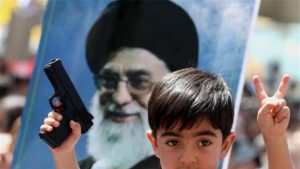When it comes to the Syrian war, Iran is in the driver seat, not Syrian President Bashar Assad. For Tehran, Syria is a core pillar of its hegemonic strategy, like reported by eurasiareview.com
Iran has penetrated every Syrian governmental organization, including its security and military infrastructures. It boasts about orchestrating battles and having thousands of fighters on the ground across Syria. Iran is the most important guarantor and supporter of Assad.
Iran’s Revolutionary Guard Corps (IRGC) and its elite Qud Force, which operates beyond Iran’s borders, are key elements behind the continuation and escalation of Syria’s civil war. Iran also relies on its paramilitary groups and Shiite militia proxies such as Hezbollah to fight for Assad.
As such, one of the most effective ways to resolve the war is to eliminate or cut down Iran’s intervention. A multilateral approach is required: Economic, political, humanitarian, military and diplomatic.
The most important dimension is economic. Iran is hemorrhaging billions of dollars on Assad’s forces, and paying foreigners to fight in Syria. Tehran’s financial assistance to Assad is among the most critical factors in prolonging the civil war, so cutting this lifeline is vital.
In 2014, Iran was in a difficult situation financially due to the UN Security Council’s (UNSC) four rounds of sanctions. The pressure on Tehran was reflected in speeches by Supreme Leader Ali Khamenei, who anxiously called on Assad to control the situation in Syria. Iran showed signs of willingness to abandon Assad, but not his Alawite state.
Unfortunately, the nuclear deal changed things. Billions of dollars poured into Iran’s treasury, providing significant relief. Financial and military support for Assad increased, and Tehran publicly acknowledged having forces on the ground in Syria.
One way to cut the financial lifeline to Assad is to re-impose sanctions on Tehran. These sanctions can be unilateral, multilateral, coalition-based or passed by the UNSC. Tehran has already violated the nuclear deal several times. It should be closely watched for other violations of the agreement and held accountable.
Significant pressure will be felt if a coalition of regional powers cuts economic ties with Iran. This will result in Western powers avoiding trade with it. Sanctioning Iranian organizations and figures, including the IRGC, is also vital.
If governments, particularly regional and Islamic, begin cutting diplomatic ties with Iran, it will be pressured to rethink its role in Syria. Tehran’s legitimacy will be damaged, and it will be unable to effectively project itself as the leader of the Muslim world. Such diplomatic pressure will resonate worldwide.
Establishing a no-fly zone near the Syrian border is crucial. This can be carried out in unison by the US, EU and regional powers. A no-fly zone will put significant pressure on Tehran’s aerial operations in Syria, and restrict Assad’s aerial support of Iranian fighters on the ground. This will be a critical boost to Syrian opposition groups.
Cases should be pursued to bring to justice Iranian leaders and organizations engaged in crimes against humanity in Syria. The International Criminal Court (ICC), Amnesty International, the UN and human rights organizations can be used to achieve this. Also, the international community needs to draw more attention to human rights abuses in Iran.
Implementing this multilateral approach will diminish its support of Assad and its intervention in Syria. This could significantly change the regional balance of power and the direction of the war in Syria, as well as put an end to atrocities there.



